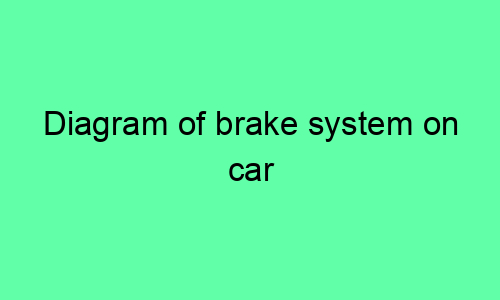## Diagram of Brake System on a Car
### Overview
The brake system is a critical component of any vehicle, responsible for slowing down and stopping the car safely and effectively. It consists of several interconnected parts that work together to generate friction and convert the car’s kinetic energy into heat.
### Components of the Brake System
#### 1. Brake Pedal
* **Function:** Initiates the braking process when depressed.
* **Location:** Mounted inside the driver’s cabin, connected to the master cylinder.
#### 2. Master Cylinder
* **Function:** Converts the mechanical force from the brake pedal into hydraulic pressure.
* **Location:** Mounted in the engine compartment, connected to the brake lines.
#### 3. Brake Lines
* **Function:** Transmit the hydraulic pressure from the master cylinder to the brake calipers and wheel cylinders.
* **Material:** Typically made of steel or high-pressure rubber hoses.
#### 4. Brake Calipers (Disc Brakes)
* **Function:** House the brake pads and apply pressure to the brake rotors to slow down the wheels. Located at each wheel on disc brake systems.
* **Components:** Consist of a caliper body, pistons, and brake pads.
#### 5. Brake Rotors (Disc Brakes)
* **Function:** Provide a friction surface for the brake pads to grip against and create braking force. Mounted on the wheel hubs at each corner of the car.
#### 6. Wheel Cylinders (Drum Brakes)
* **Function:** Use hydraulic pressure to expand brake shoes against the inside of brake drums to create braking force. Used in drum brake systems.
* **Components:** Consist of a cylinder, pistons, and brake shoes.
#### 7. Brake Drums (Drum Brakes)
* **Function:** Provide a friction surface for the brake shoes to grip against and create braking force. Mounted on the wheel hubs at each corner of the car, enclosing the wheel cylinders.
#### 8. Brake Pads
* **Function:** Friction material that makes contact with the brake rotors or drums to generate braking force.
* **Material:** Typically made of organic or semi-metallic compounds.
#### 9. Brake Shoes
* **Function:** Friction material that makes contact with the inside of brake drums to generate braking force. Used in drum brake systems.
#### 10. Brake Fluid
* **Function:** Transmits hydraulic pressure through the brake lines from the master cylinder to the brake calipers or wheel cylinders.
* **Properties:** Must maintain high boiling points and not absorb moisture to prevent brake fade.
### Working Principle of the Brake System
When the brake pedal is depressed, the master cylinder converts the mechanical force into hydraulic pressure, which is then transmitted through the brake lines to the brake calipers or wheel cylinders. In disc brake systems, the brake calipers apply pressure to the brake pads, which in turn grip the brake rotors and create friction. This friction slows down the rotation of the brake rotors, which transfers the braking force to the wheels. In drum brake systems, the brake wheel cylinders apply pressure to the brake shoes, which expand and rub against the inside of the brake drums, generating friction to slow down the wheels.
### Types of Brake Systems
There are two main types of brake systems used in cars:
#### 1. Disc Brake System
* **Advantages:** Provides more precise braking control, higher heat dissipation, and better resistance to brake fade.
* **Disadvantages:** Can be more expensive to maintain and repair.
#### 2. Drum Brake System
* **Advantages:** More affordable to produce and maintain.
* **Disadvantages:** Less precise braking control and higher susceptibility to brake fade.
### Safety Features of Brake Systems
Modern brake systems incorporate various safety features to enhance the safety and effectiveness of braking, including:
* **Anti-lock Braking System (ABS):** Prevents wheel lockup and allows for controlled braking on slippery surfaces.
* **Electronic Brakeforce Distribution (EBD):** Distributes braking force more effectively between the front and rear wheels based on load conditions.
* **Brake Assist:** Amplifies brake pressure when the brake pedal is applied quickly and forcefully.
* **Hill-Start Assist:** Prevents the car from rolling backward on hills while starting.
* **Automatic Emergency Braking (AEB):** Automatically applies the brakes if an imminent collision is detected.
### Maintenance and Repair
To ensure optimal performance and safety, regular maintenance and inspection of the brake system are crucial. Some common maintenance tasks include:
* **Brake fluid replacement:** Replacing the brake fluid every 2-3 years or as per manufacturer recommendations to prevent brake fade.
* **Brake pad replacement:** Replacing worn-out brake pads to maintain sufficient friction for effective braking.
* **Brake rotor inspection:** Inspecting brake rotors for wear or damage and replacing them if necessary.
* **Caliper inspection:** Ensuring proper functioning of the brake calipers, including piston movement and seal condition.
### Conclusion
The brake system plays a vital role in ensuring the safe operation of a car by providing reliable and effective braking performance. Understanding the components and working principle of the brake system empowers drivers with the knowledge to maintain and repair their vehicles, enhancing safety and driving confidence.






